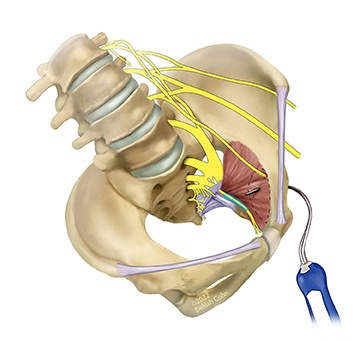TOTs cause man-made pudendal and obturator neuralgia, a burning or stabbing pain that follows the path of a nerve.
Greg Vigna, MD, JD, national product liability attorney, practicing physician, and Certified Life Care Planner states, “The 2020 Joint Position Statement on the Management of Mesh-Related Complications for the FPMRS Specialist has acknowledged that pudendal and obturator neuralgia is caused by the polypropylene arms of transobturator (TOT) slings and it relates in part to nerve entrapment. The American Urogynelogical Society and the International Urogynecological Association has recognized ‘extrapelvic pain’ as a unique complication caused by the arms of transobturator slings and explains that this pain, in part, is by obturator and pudendal neuralgia from nerve entrapment. Essentially, TOTs cause man-made pudendal and obturator neuralgia.”
“Pudendal neuralgia and obturator neuralgia occurring in the same person has never been described in the medical literature unless there is a transobturator (TOT) polypropylene device.” — Greg Vigna, M.D., J.D., Certified Life Care Planner
Neuralgia is defined by The Harvard Educational Website as ‘a burning or stabbing pain that follows the path of a nerve’ and by Webster’s Dictionary as ‘acute paroxysmal pain radiating along the course of one or more nerves usually without demonstrable changes in the nerve structure’.
Dr. Vigna adds, “Pudendal neuralgia and obturator neuralgia occurring in the same person has never been described in the medical literature unless there is a transobturator (TOT) polypropylene device. The reason for this is that these nerves are not anatomically close to each other so it is unlikely that both nerves would be injured in the case of trauma or by misplacement of a suture, trocar, or surgical retractor. The pudendal and obturator nerve is, however, adjacent the obturator internus muscle which is impacted by every polypropylene TOT sling on the market. The obturator internus muscle is injured acutely during placement of a TOT as it is surgically placed through or into the obturator internus muscle with a trocar. There is always an acute inflammation followed by chronic inflammation that is ongoing as the polypropylene mesh triggers an perpetual immunological response known as the foreign body reaction that leads to scarification, inflammation, and tissue/mesh contraction the degree of which in some women can be excessive. The changes in the soft tissues and obturator internus muscle impacted by the mesh may lead to injury or irritation to the obturator and pudendal nerves that are adjacent to this muscle.”

Figure 1
Figure 1:
Out-to-in trocar for a TOT going through the obturator foramen into and through the obturator internus muscle. The obturator nerve is shown connecting to the Lumbar 2nd to 4th nerve roots passing through the obturator canal at the superior aspect of the obturator foramen and the pudendal nerve connecting to the Sacral 2nd to 4th nerve roots passing through Alcock’s canal formed by the fascia of the obturator internus muscle under the pubic bone.
Dr. Vigna concludes, “Our case criteria are women with symptoms of pudendal, obturator, or ilioinguinal neuralgia caused by mid-urethral slings and pelvic organ prolapse transvaginal mesh devices as explained by the 2020 Joint Position Statement. To date these specific injuries have not been warned by the manufacturers. To date, defendant manufacturers have not warned of the magnitude of risk of extrapelvic pain caused by transobturator slings compared with extrapelvic pain caused by retropubic slings. There are safer alternative procedures and safer alternative designs that eliminate the risk of neuralgia caused by mid-urethral slings.”
Symptoms of pudendal and obturator neuralgia caused by transobturator slings include:
Dr. Vigna is a California and Washington DC lawyer who focuses on catastrophic injuries including neurological injuries caused by transvaginal mesh devices resulting in pudendal neuralgia, obturator neuralgia, and complex regional pain syndrome. Dozens of cases are filed across the country with Martin Baughman, PLLC. Ben Martin and Laura Baughman are national pharmaceutical injury attorneys in Dallas, Texas.
Learn more on the anatomical basis for TOT complications including obturator and pudendal neuralgia and the treatments of obturator and pudendal neuralgia.
Read our FREE BOOK on Vaginal Mesh Pain and for articles, video resources, and information visit the Pudendal Neuralgia Educational Portal or https://tvm.lifecare123.com/.
Visit https://tvm.lifecare123.com/slingebook.html for information regarding sling related complications.
References:
Consent Order: https://www.clydeco.com/clyde/media/fileslibrary/Consent_Judgment_-_Ethicon.pdf
2020 AUGS-IUGA Joint Position Statement on the Management of Mesh-Related Complications for the FPMRS Specialist (See extrapelvic pain): https://www.augs.org/assets/1/6/Joint_Position_Statement_on_the_Management_of.99428.pdf
Greg Vigna, MD, JD
Vigna Law Group
+1 800-761-9206
email us here
Visit us on social media:
Facebook
Twitter
LinkedIn
[/fusion_text][fusion_button link=”https://0e190a550a8c4c8c4b93-fcd009c875a5577fd4fe2f5b7e3bf4eb.ssl.cf2.rackcdn.com/EINPresswire-565037709-vigna-law-group-transobturator-slings-man-made-obturator-and-pudendal-neuralgia-3.pdf” title=”” target=”_blank” link_attributes=”” alignment_medium=”” alignment_small=”” alignment=”center” modal=”” hide_on_mobile=”small-visibility,medium-visibility,large-visibility” sticky_display=”normal,sticky” class=”” id=”” color=”default” button_gradient_top_color=”” hue=”” saturation=”” lightness=”” alpha=”” button_gradient_bottom_color=”” button_gradient_top_color_hover=”” button_gradient_bottom_color_hover=”” gradient_start_position=”” gradient_end_position=”” gradient_type=”” radial_direction=”” linear_angle=”180″ accent_color=”” accent_hover_color=”” type=”” bevel_color=”” bevel_color_hover=”” border_top=”” border_right=”” border_bottom=”” border_left=”” border_radius_top_left=”” border_radius_top_right=”” border_radius_bottom_right=”” border_radius_bottom_left=”” border_color=”” border_hover_color=”” size=”” padding_top=”” padding_right=”” padding_bottom=”” padding_left=”” fusion_font_family_button_font=”” fusion_font_variant_button_font=”” font_size=”” line_height=”” letter_spacing=”” text_transform=”” stretch=”default” margin_top=”” margin_right=”” margin_bottom=”” margin_left=”” icon=”fa-file-pdf fas” icon_position=”left” icon_divider=”no” animation_type=”” animation_direction=”left” animation_speed=”0.3″ animation_offset=””]View PDF[/fusion_button][/fusion_builder_column][/fusion_builder_row][/fusion_builder_container]
8939 S. Sepulveda Blvd. Suite 102
Los Angeles, CA, 90045
Dr. Greg Vigna, is the principal of Greg Vigna, MD, JD, PLC, a California personal injury law firm, and his law firm has a non-exclusive referral relationship with the attorneys listed within this site. Dr. Vigna, co-counsels with attorneys across the country.